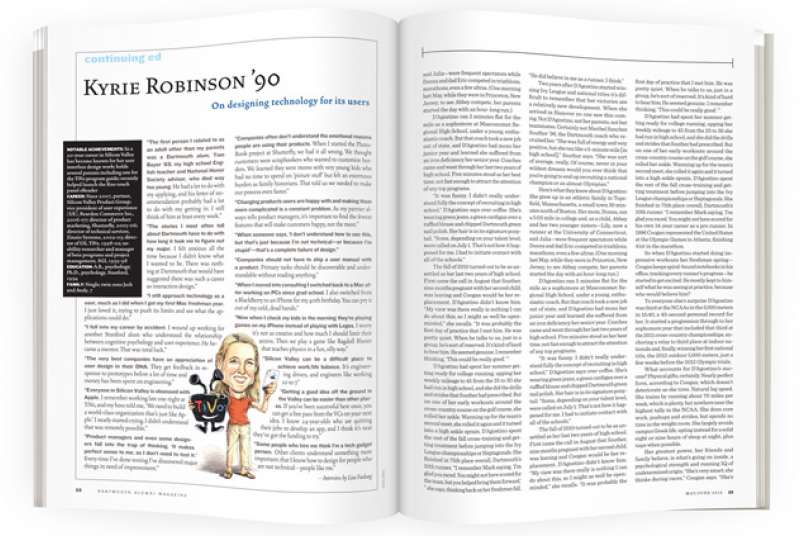
Kyrie Robinson ’90
Notable Achievements: In a 20-year career in Silicon Valley has become known for her user interface design work; holds several patents including one for the TiVo program guide; recently helped launch the Kno touch panel eReader Career: Since 2007, partner, Silicon Valley Product Group; vice president of user experience (UE), Reardon Commerce Inc., 2006-07; director of product marketing, Shutterfly, 2003-06; director of technical services, Zinnio Systems, 2002-03; director of UE, TiVo, 1998-02; usability researcher and manager of beta programs and project management, SGI, 1995-98 Education: A.B., psychology; Ph.D., psychology, Stanford, 1994 Family: Single; twin sons Jack and Andy, 7
“The first person I related to as an adult other than my parents was a Dartmouth alum, Tom Baer ’70, my high school English teacher and National Honor Society advisor, who died way too young. He had a lot to do with my applying, and his letter of recommendation probably had a lot to do with my getting in. I still think of him at least every week.”
“The stories I most often tell about Dartmouth have to do with how long it took me to figure out my major. I felt anxious all the time because I didn’t know what I wanted to be. There was nothing at Dartmouth that would have suggested there was such a career as interaction design.”
“I still approach technology as a user, much as I did when I got my first Mac freshman year. I just loved it, trying to push its limits and see what the applications could do.”
“I fell into my career by accident. I wound up working for another Stanford alum who understood the relationship between cognitive psychology and user experience. He became a mentor. That was total luck.”
“The very best companies have an appreciation of user design in their DNA. They get feedback in response to prototypes before a lot of time and money has been spent on engineering.”
“Everyone in Silicon Valley is obsessed with Apple. I remember working late one night at TiVo, and my boss told me, ‘We need to build a world-class organization that’s just like Apple.’ I nearly started crying. I didn’t understand that was remotely possible.”
“Product managers and even some designers fall into the trap of thinking, ‘It makes perfect sense to me, so I don’t need to test it.’ Every time I’ve done testing I’ve discovered major things in need of improvement.”
“Companies often don’t understand the emotional reasons people are using their products. When I started the PhotoBook project at Shutterfly, we had it all wrong. We thought customers were scrapbookers who wanted to customize borders. We learned they were moms with very young kids who had no time to spend on ‘picture stuff’ but felt an enormous burden as family historians. That told us we needed to make our process even faster.”
“Changing products users are happy with and making them more complicated is a constant problem. As my partner always tells product managers, it’s important to find the fewest features that will make customers happy, not the most.”
“When someone says, ‘I don’t understand how to use this, but that’s just because I’m not technical—or because I’m stupid’—that’s a complete failure of design.”
“Companies should not have to ship a user manual with a product. Primary tasks should be discoverable and understandable without reading anything.”
When I moved into consulting I switched back to a Mac after working on PCs since grad school. I also switched from a BlackBerry to an iPhone for my 40th birthday. You can pry it out of my cold, dead hands.”
“Now when I check my kids in the morning they’re playing games on my iPhone instead of playing with Legos. I worry it’s not as creative and how much I should limit their access. Then we play a game like Ragdoll Blaster that teaches physics in a fun, silly way.”
“Silicon Valley can be a difficult place to achieve work/life balance. It’s engineering driven, and engineers like working 10 to 7.”
“Getting a good idea off the ground in the Valley can be easier than other places. If you’ve been successful here once, you can get a free pass from the VCs on your next idea. I know 24-year-olds who are quitting their jobs to develop an app, and I think it’s neat they’ve got the funding to try.”
“Some people who hire me think I’m a tech gadget person. Other clients understand something more important: that I know how to design for people who are not technical—people like me.”
—Interview by Lisa Furlong










